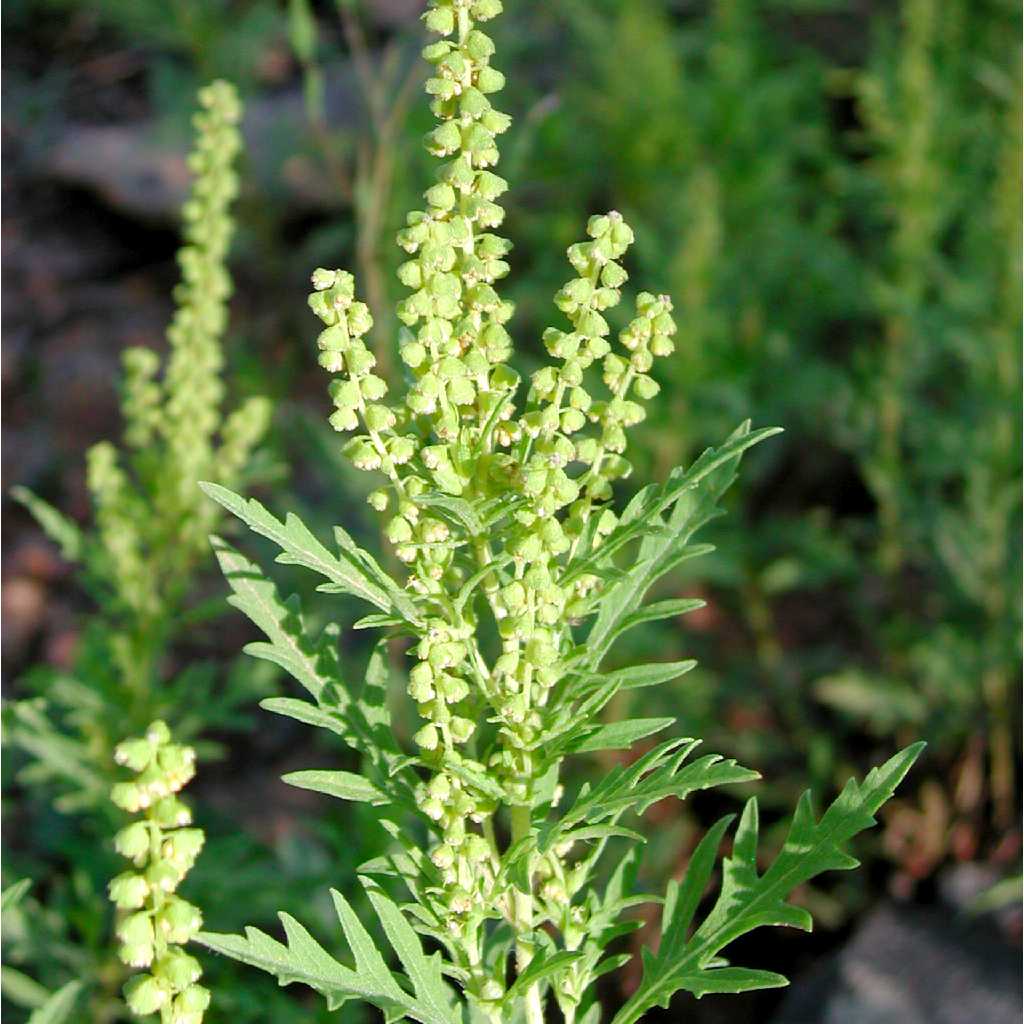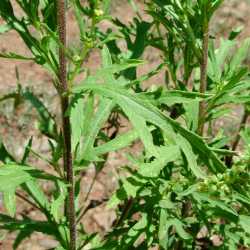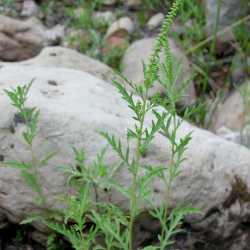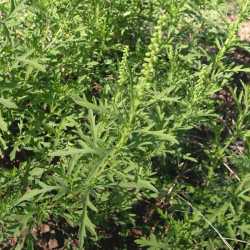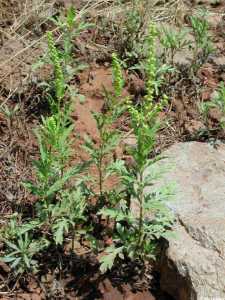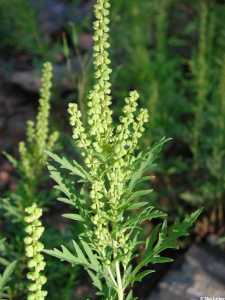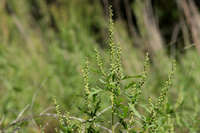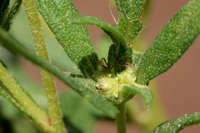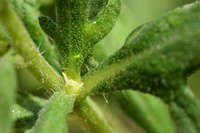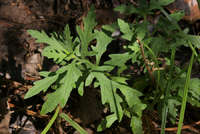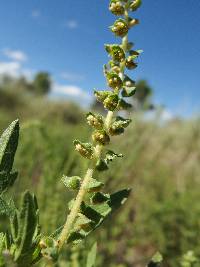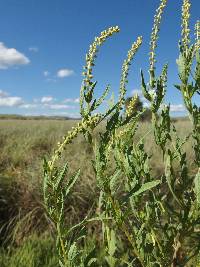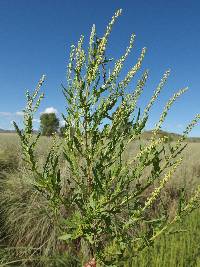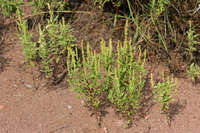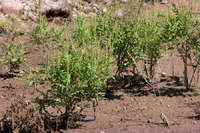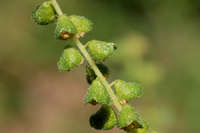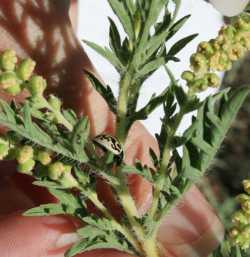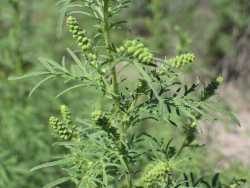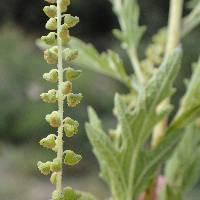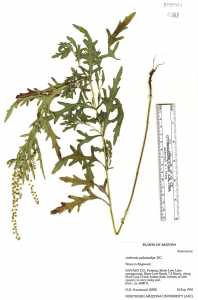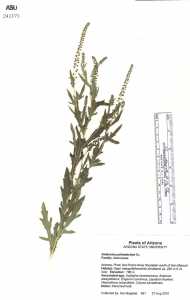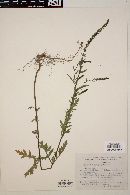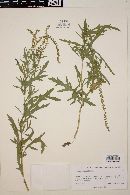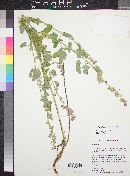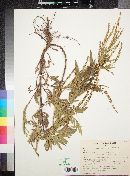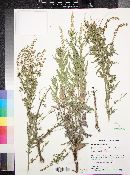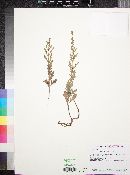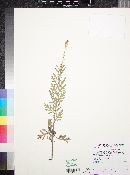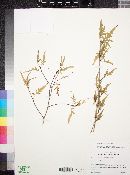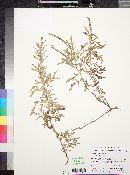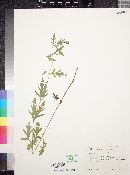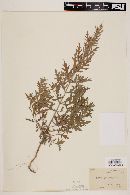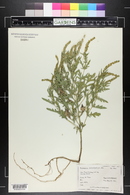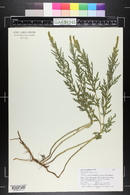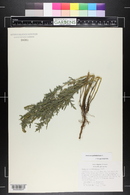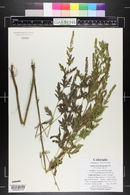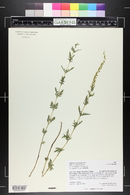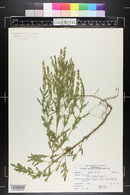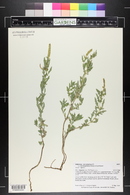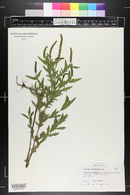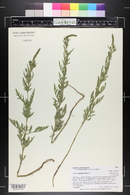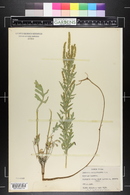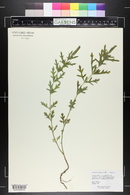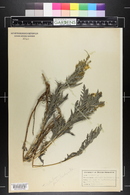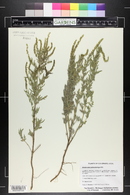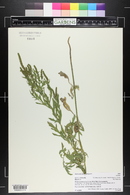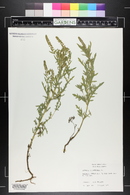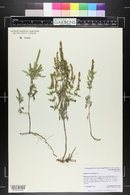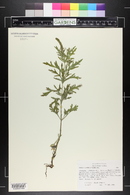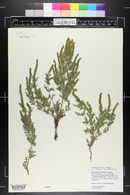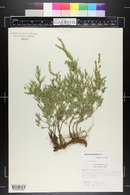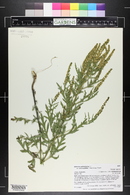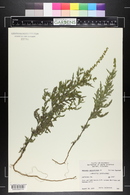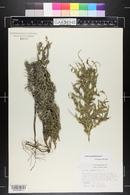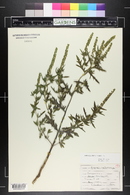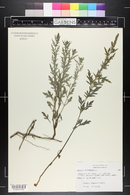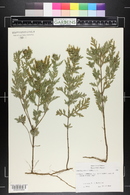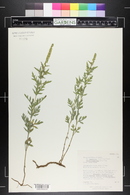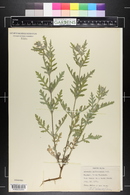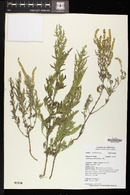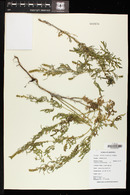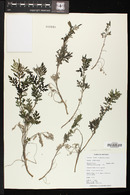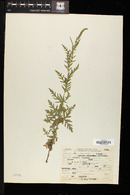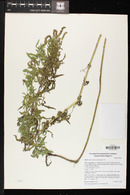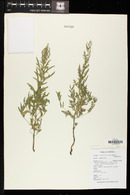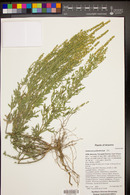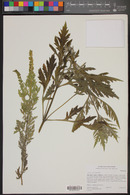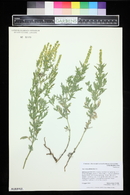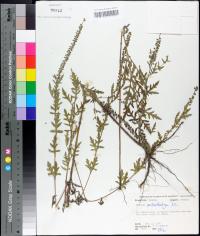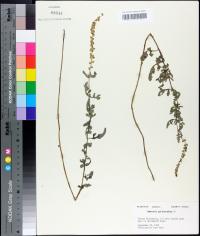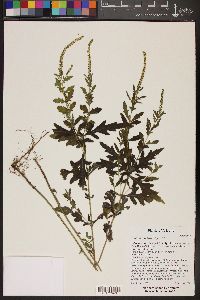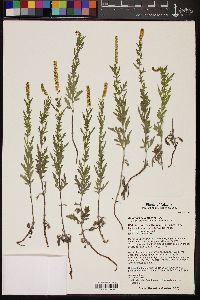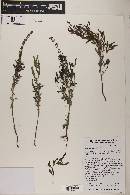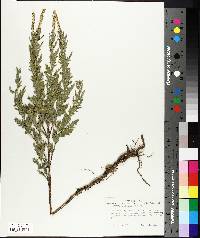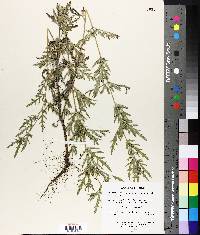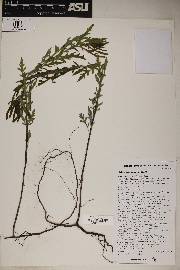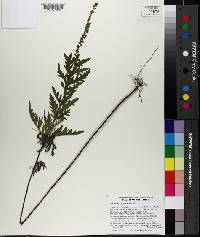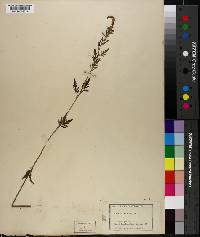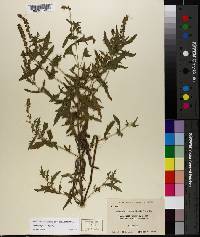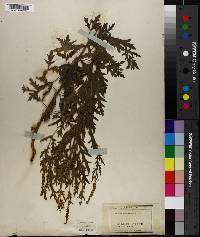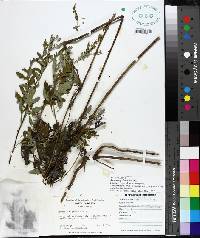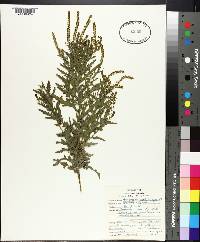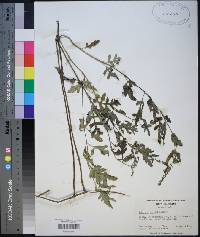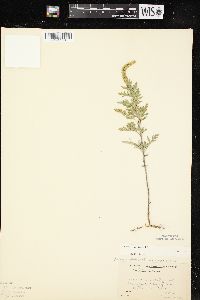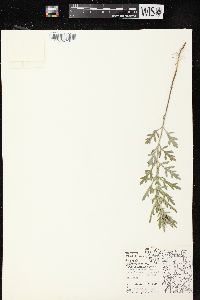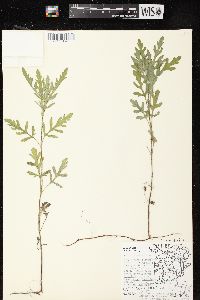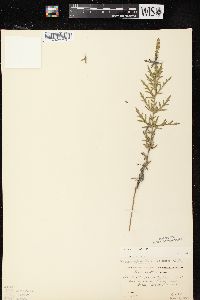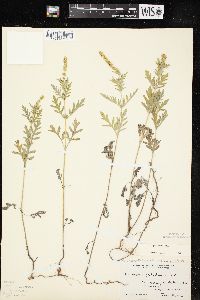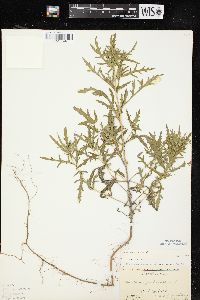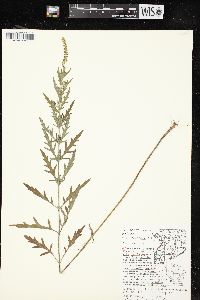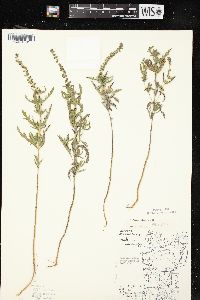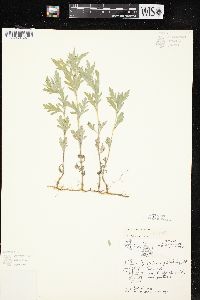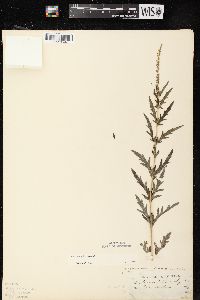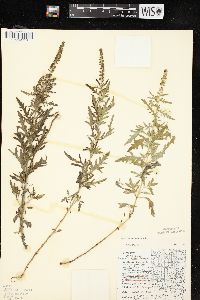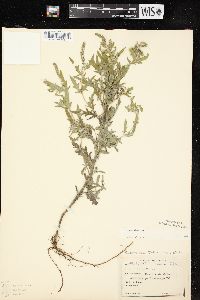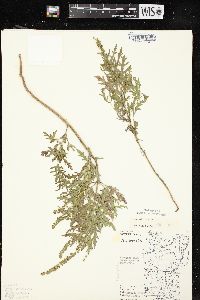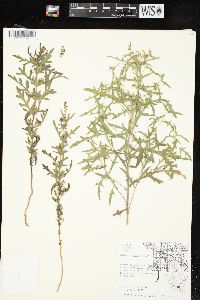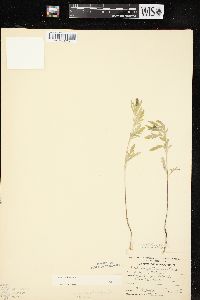Ambrosia psilostachya
|
|
|
|
Family: Asteraceae
Perennial Ragweed
[Ambrosia californica Rydb., moreAmbrosia coronopifolia Torr. & A. Gray, Ambrosia cumanensis auct. non Kunth, Ambrosia lindheimeriana Schcele, Ambrosia psilostachya var. californica (Rydb.) Blake, Ambrosia psilostachya var. coronopifolia (Torr. & A. Gray) Farw., Ambrosia psilostachya var. lindheimeriana (Scheele) Blank., Ambrosia psilostachya var. psilostachya , Ambrosia rugelii Rydb., Franseria psilostachya DC.] |
Perennials, 10-60(-100+) cm. Stems erect. Leaves proximally opposite, distally alternate; petioles 0-25 mm (often ± winged); blades deltate to lanceolate, 20-60(-140) × 8-35(-50+) mm, pinnately toothed to 1-pinnately lobed, bases cuneate to truncate, ultimate margins entire or toothed, abaxial and adaxial faces hirsutulous to strigose and gland-dotted. Pistillate heads clustered, proximal to staminates; florets 1. Staminate heads: peduncles 0.5-2 mm; involucres obliquely cup-shaped, 2-4(-5) mm diam., hirsutulous; florets 5-15(-30+). Burs: bodies ± obpyramidal to globose, 2-3 mm, hirsutulous, spines or tubercles 0 or 1-6, mostly distal, stoutly conic to acerose, (0.1-)0.5-1 mm, tips straight. 2n = 18, 27, 36, 45, 54, 63, 72, 100-104, 108, 144. Flowering Jul-Oct(-Dec). Disturbed sites, often wet, alkaline, clay soils; 0-2200 m; Alta., B.C., Man., N.S., Ont., P.E.I., Que., Sask.; Ala., Ariz., Ark., Calif., Colo., Fla., Ga., Idaho, Ill., Ind., Iowa, Kans., La., Maine, Mass., Mich., Minn., Miss., Mo., Mont., Nebr., Nev., N.H., N.Mex., N.Y., N.C., N.Dak., Ohio, Okla., Oreg., Pa., S.C., S.Dak., Tenn., Tex., Utah, Vt., Wash., Wis., Wyo.; Mexico (Baja California, Chihuahua, Coahuila). Hybrids between Ambrosia psilostachya and A. artemisiifolia have been called A. ×intergradiens W. H. Wagner. Some botanists consider the type of A. cumanensis Kunth (1818) to be conspecific with that of A. psilostachya.
FNA 2006, Wiggins 1964, Kearney and Peebles 1969, Heil et al 2015 Duration: Perennial Nativity: Native Lifeform: Forb/Herb General: Colonial perennial herb, 20-100 cm tall, arising from deep, creeping rhizomes; herbage rough-pubescent and gland dotted. Leaves: Opposite below and alternate above, sessile or petiolate, the petioles to 2 cm; blades thick and firm, pinnatifid, with broad midstripe; mostly 2-6 cm long, 1-4 cm wide. Flowers: Pistillate and staminate flowers in separate heads; all heads discoid; staminate heads pendant in terminal racemes; pistillate heads in the upper leaf axils or in the raceme below the staminate heads. Pistillate heads with 1 floret each, 4-6 mm long, with one set of short tubercles (or lacking). Staminate heads with cup-shaped involucres, 1-2 mm in diameter, papillose-strigose to hispidulous, gland dotted; containing 8-24 disc flowers. Fruits: Burs brown, obpyramidal to globose, 2-3 mm, hirsutulous, without spines or with up to 6 spines, 1 mm long. Ecology: Found in disturbed places and streamsides, from 4,000-7,000 ft (1300-2100 m); flowers July-October. Distribution: Cosmopolitan; in Europe, Australia and S. Africa; throughout most of N. America and every state in the US; south to s MEX. Notes: Ambrosias are shrubs or herbs with heads of all disk flowers that produce hard fruits or spiny burs. A. psilostachya is a widespread, common species distinguished by being a perennial herb, 10-70cm tall, from long rhizomes that form clonal colonies; leaves that are deeply 1-2X pinnately dissected, and cup-shaped heads. Ambrosia acanthacarpa is similar, but that species is annual and has larger burs (4-8 mm) with 6-30 longer straight spines. Ambrosia confertiflora is also similar, but that species has burs with hooked spines and has a woody taproot rather than rhizomes. Ethnobotany: Cheyenne used leaves and stems to remedy painful digestion, as a laxative, for labor pain and as a cold treatment. Keres, Kiowa and Deguena tribes used stem and leaf tonic for dandruff. Plant also rolled with sage in Kiowa sweatlodge. Etymology: Ambrosia is Greek for food of the gods, while psilostachya comes from Greek psilos for smooth or bare and stachy for flower spike. Synonyms: Ambrosia californica, A. coronopifolia, A. cumanensis, A. psilostachya var. californica, A. psilostachya var coronopifolia, A. psilostachya var. lindheimeriana, A. rugelii Editor: SBuckley 2010, FSCoburn 2014, AHazelton 2015 From Flora of Indiana (1940) by Charles C. Deam This is a western species that has been reported several times in Indiana, probably mostly as a railroad migrant. It has been reported from the dunes by Peattie and I have a specimen from near Hammond. It has also been reported from Jefferson and Marion Counties, and from the Lower Wabash Valley. In 1933 I found it as a common weed in dry, sandy soil along the C. E. & I. Railroad just south of Emison, Knox County. It is common in sandy soil in a woods about 1 mile southeast of Notre Dame, St. Joseph County (Nieuwland). Ek has found it in two places along railroads in Howard County. ...... Indiana Coefficient of Conservatism: C = null, non-native Wetland Indicator Status: FACU Diagnostic Traits: Perennial with horizontal rhizomes; leaves opposite, deeply dissected; pollen-bearing heads in spike- or raceme-like arrays; fruits in axiles of upper leaves, 2-3 mm long, with 0-4 tubercles. |
|
|
|

